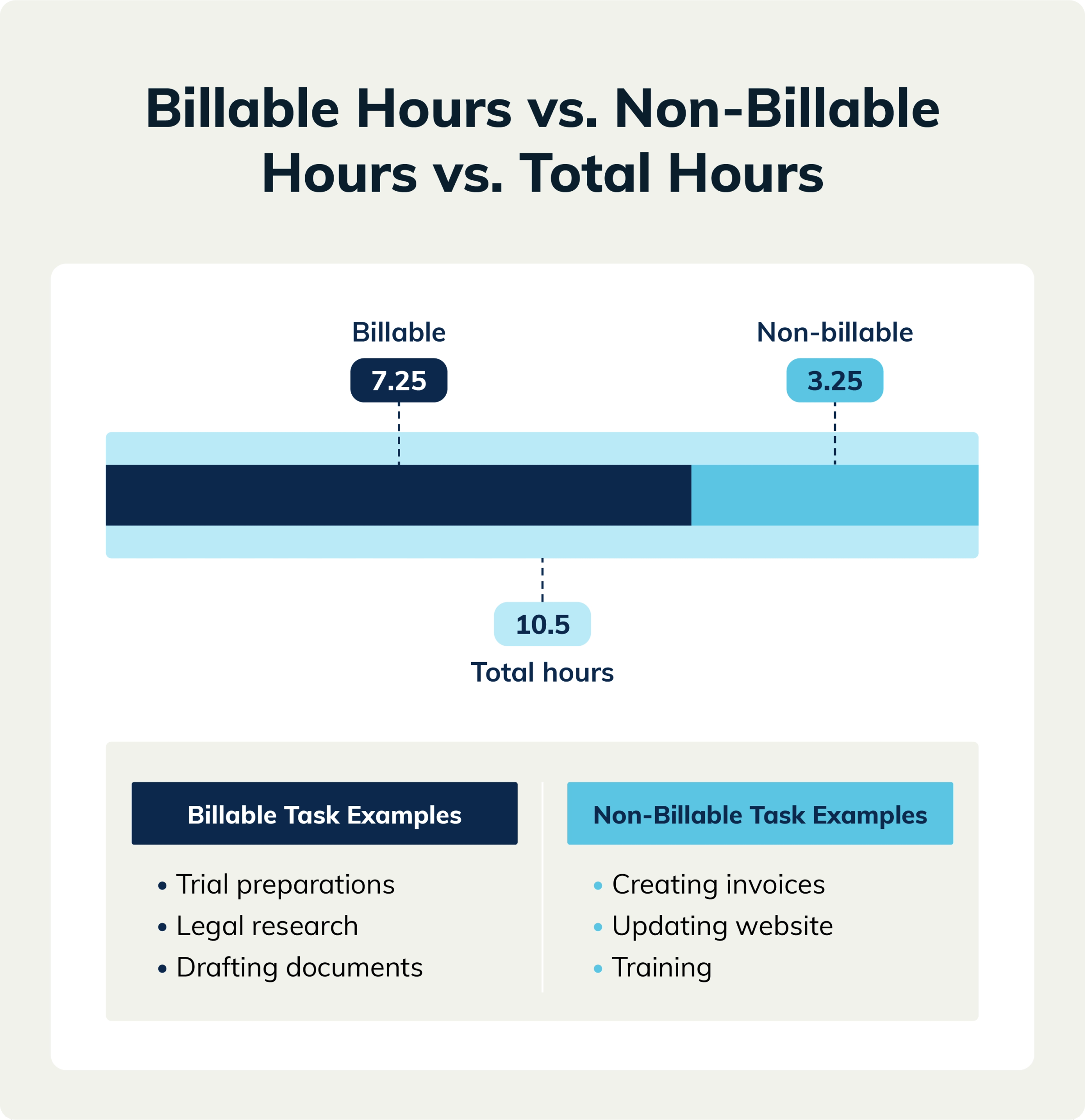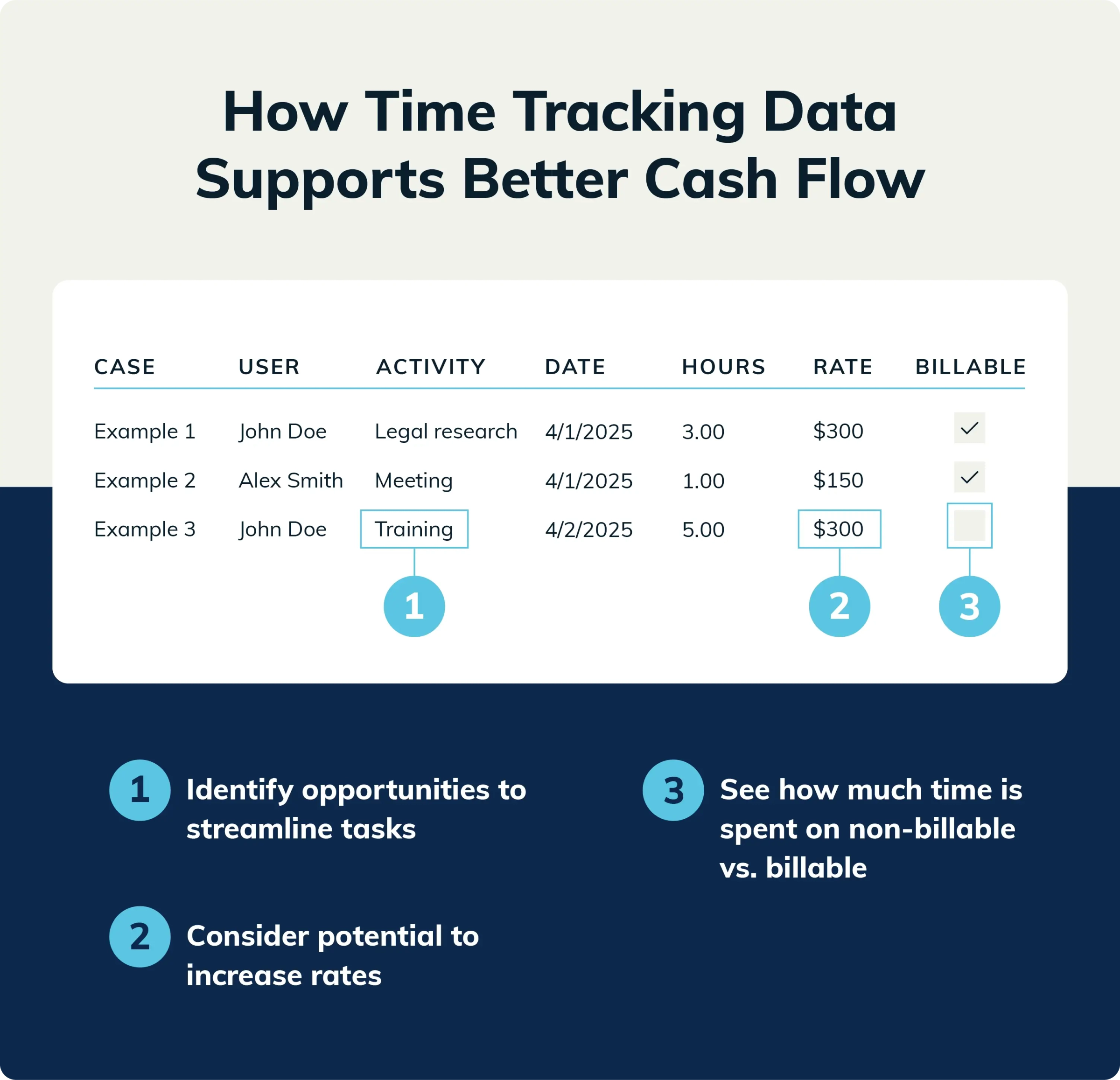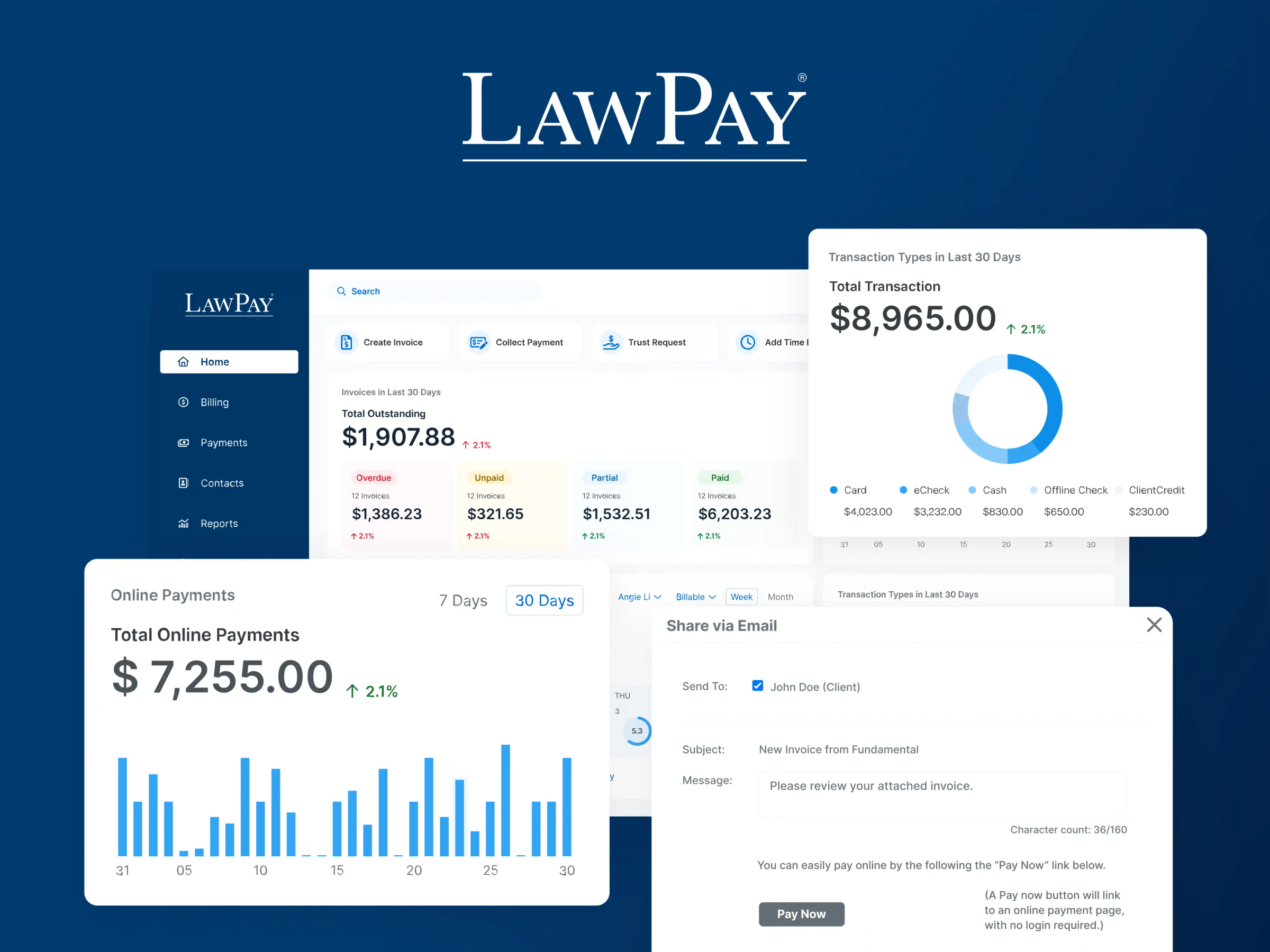Are your firm’s late nights chipping away at your bottom line? Comparing billable hours vs. hours worked may reveal unexpected discrepancies for your firm’s profitability. You may find that your staff is tracking fewer attorney billable hours than expected, or administrative tasks are taking a significant amount of time.
These issues can arise if your staff tracks hours manually or doesn’t have a standardized time tracking process. Defining the differences between billable, non-billable, and actual time tracked is the first step to more streamlined data and an optimized workflow.
In this guide, we’ll explain the differences between billable hours vs. actual hours, share tips for tracking your time more efficiently, and share how better time tracking can contribute to better law firm financial management.
What’s the Difference Between Non-Billable Hours vs. Billable Hours vs. Actual Hours?
The main difference between billable vs. non-billable hours is whether you work for clients or internal needs, while actual hours are the total hours you work in a day.
Finding the right balance between billable and non-billable hours is an important aspect of effective law firm management. Maximizing billable hours can directly impact your firm’s revenue, but non-billable work is essential to running your practice. We’ll go over the differences between all of these definitions below.
Billable Hours
Billable hours are time logged for tasks contributing to a client’s case. Some examples of billable hours for lawyers include:
Meeting with clients to discuss their case
Drafting or reviewing documents such as legal briefs, court pleadings, or contracts
Conducting legal research specific to a client's case
Communication with clients in person or via email, phone, mail, or text
Preparing for and attending depositions
Trial and witness prep
Settlement negotiations
Appearing in court, attending meetings, or arbitration proceedings
Non-Billable Hours
Non-billable hours are time spent on internal tasks for the firm but not for a specific client’s case.
Examples of non-billable tasks include:
Staff meetings or staff recruitment
Attending training sessions or mentoring colleagues
Doing business development activities, such as developing a marketing strategy to attract new clients or updating your website
Completing pro bono work
Researching or reviewing software tools, legal research software, or industry publications
Completing time sheets
Preparing client invoices
Actual Hours
Actual hours include the total time spent doing billable and non-billable work. For example, if you do two hours of business development work and have eight total lawyer billable hours, your actual hours are 10. Analyzing the total can help inform decisions about workload, assignments, and shed light on workflow issues around billable and non-billable work.

Category | Description | Impact on Law Firm |
|---|---|---|
Billable Hours | Hours worked that you can bill to clients | Directly generates revenue from client payments |
Non-Billable Hours | Hours worked on administrative tasks that you cannot bill to clients | Helps your firm operate efficiently and supports long-term, scalable growth |
Actual Hours | Total hours worked | Reflects the total of your contributions |
How to Track Billable Hours Separately from Non-Billable and Actual Hours
You can track billable hours with paper, in a spreadsheet or document, or with legal time tracking software.
Below are a few common time-tracking methods and what to consider for each:
Method | Pros | Cons |
|---|---|---|
Paper | Easy and affordable for staff to adopt | Manually recording and transferring time entries to invoices is error-prone and takes time |
Spreadsheets or documents | Can standardize some aspects and can help centralize time tracking entries | May have versioning issues if staff begins using multiple sheets throughout the month |
Time-tracking software | Standardizes and automates | Adoption may take time, and price can be a barrier |
Although paper or spreadsheets feel familiar, finding a great time tracking solution made for lawyers can help eliminate the common issues from these manual methods. For example, software solutions like LawPay can let you start and stop multiple timers as you multitask for several clients. Timers allow you to accurately capture billable time without needing to write down start and end times for each task.
How to Calculate Billable Hours
Calculating billable hours as a lawyer varies depending on the industry or practice size. Some use an attorney billable hours chart, others use a custom calculation, while others use software to automate and standardize calculations.
Regardless of the method, there are a few common steps for lawyers to effectively track their billable hours.
Choose a format to log hours. For example, you may track your time in six-minute or 10-minute increments.
Select the tool(s) needed to track time. Decide whether to use software, paper, a spreadsheet, or a combination of tools that work for your staff’s workflow and budget.
Log time as you complete work. It's easier to bill as you go so that you can be more accurate. If you batch bill, it may be hard to remember what you worked on and how long you spent on each task.
Calculate billable rates when generating invoices. For example, if a lawyer logged 5.9 hours for a task at $300/hour, you’ll bill this as $1,770.
How Many Hours Should Law Firms Bill?
The number of hours a law firm should bill will vary based on the practice area, legal matter, client, and staff member working on each case.
In addition to total hours billed, keeping a close eye on your law firm's other key performance indicators (KPIs) helps ensure you are working efficiently and meeting your revenue goals. This can include reviewing workload distribution amongst your staff to ensure appropriate resource allocation.
For example, instead of giving all lawyers the same billable hour goal, it may be more effective to strategically assign attorneys to the most valuable tasks for their skill level. You can take non-billable work off a senior lawyer’s plate so they can work on more profitable and complex case work. Then, you can assign non-billable work to junior lawyers or support staff.
Best Practices for Increasing Billable Time
Law firms can increase billable hours by establishing uniform time tracking guidelines for their staff, delegating or automating non-billable tasks, and using data to identify areas for improvement. We’ll go over these and other best practices below:
Share consistent time tracking guidelines to encourage accurate and standardized time tracking entries
Delegate non-billable tasks (when possible) to support staff or less senior lawyers
Automate repetitive billable and non-billable tasks to free up time to complete billable work
Minimize distractions by creating a work environment that limits interruptions
Review time tracking data regularly to identify process issues and opportunities for improvement
Adjust rates as needed based on insights from time tracking data, like if certain tasks consistently take a long time, but the billable rate doesn’t reflect the effort and skills required to complete the task
Educate clients during the start of a case on your firm’s billing method to minimize questions and billing disputes
Leverage time tracking software to streamline the time tracking process, centralize data, and sync with invoicing
How to Leverage Accurate Actual, Billable, and Non-Billable Time Tracking Data
Accurate and standardized time tracking data can provide insights to increase your lawyers’ billable hours and improve your law firm’s cash flow each month. You can also more easily identify trends and evaluate productivity. For example, if all lawyers spend several hours creating client invoices, this may be a sign to reassess your invoicing workflow.
Below are additional ways to leverage time tracking data:
Analyze clients or lawyers with a low billing realization rate by comparing discrepancies between time tracking and invoices.
Compare time entries for similar tasks to identify inconsistencies with total time tracked, task descriptions, and differentiation between billable and non-billable work.
Review and adjust each lawyer’s utilization rate by reviewing time spent on billable and non-billable tasks.
Analyze the law firm’s overall profitability and how individual tasks and clients can impact the firm.

How Time Tracking Software Improves Billable Hours
Effective time tracking software helps many firms track billable and total hours to assess firm productivity. The 2025 Legal Industry Report revealed that 67% of firms used software with basic time tracking features, while 24% used software that automatically captured work performed in the background with passive time tracking software.
Of those firms using passive time tracking solutions, 56% reported measurable monthly time savings, with 31% saving between one and five hours per month.
Accurately Track Billable Hours With LawPay
The best lawyer time tracking software can simplify the tracking of billable and non-billable hours. LawPay’s time tracking solution includes tools like built-in timers and time tracking goals to help you maximize billable hours, while automated invoice generation helps you get paid for all the work you perform.
Schedule a demo today to learn more about how LawPay can support your practice by helping you streamline time tracking, increase efficiency, and make it easier for clients to pay.
Schedule a demo to see what LawPay can offer your firm.
Book Now
About the author

Esther ParkContent Writer
Esther Park is a content writer and Senior SEO Manager for leading legal software companies, including MyCase, Docketwise, and CASEpeer, as well as LawPay, the #1 legal payment processor. Her expertise lies in writing about emerging legal technologies and financial wellness strategies for law firms, among other topics.
